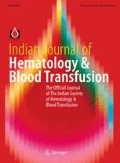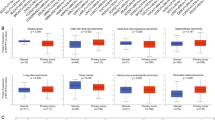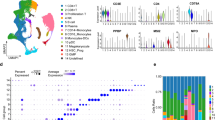Abstract
Increasing evidence of involvement of non-coding RNAs, especially long non-coding RNAs (lncRNAs), in the molecular biology of various malignancies have been recently reported. Their utilization as markers for diagnosis, prognosis and evaluation of treatment response was widely investigated. As the impact of lncRNA HOTAIR on multiple myeloma (MM) was not properly highlighted, we aimed to explore the expression levels of HOTAIR in three groups of MM patients and to analyze its relationship to different patients’ characteristics. Plasma samples were withdrawn from 24 newly diagnosed MM patients, 23 post-therapy patients in complete response (CR) or very good partial response (VGPR) and 15 patients who had either progressive disease (PD) or relapse. The expression of lncRNA HOTAIR in MM patients and 20 healthy controls was analyzed by quantitative reverse transcription polymerase chain reactions. HOTAIR was significantly upregulated in newly diagnosed and PD/relapse categories in comparison with controls and MM patients who had achieved CR or VGPR (P < 0.001). Furthermore; HOTAIR expression levels correlated with the percentage of malignant plasma cells in bone marrow (P = 0.006) and disease stage (ISS stage) (P = 0.031). HOTAIR may be employed as prognostic molecular marker and novel therapeutic tool for newly diagnosed MM patients.

Similar content being viewed by others
References
Gao D, Lv AE, Li HP, Han DH, Zhang YP (2017) LncRNA MALAT-1 elevates HMGB1 to promote autophagy resulting in inhibition of tumor cell apoptosis in multiple myeloma. J Cell Biochem 118:3341–3348
Lee HC, Wang H, Baladandayuthapani V, Lin H, He J, Jones RJ et al (2017) RNA polymerase I inhibition with CX-5461 as a novel therapeutic strategy to target MYC in multiple myeloma. Br J Haematol 177:80–94
Levin A, Hari P, Dhakal B (2018) Novel biomarkers in multiple myeloma. Transl Res 201:49–59
Sun M, Kraus WL (2015) From discovery to function: the expanding roles of long noncoding RNAs in physiology and disease. Endocr Rev 36:25–64
Yao X, Yan C, Zhang L, Li Y, Wan Q (2018) LncRNA ENST00113 promotes proliferation, survival, and migration by activating PI3K/Akt/mTOR signaling pathway in atherosclerosis. Medicine (Baltimore) 97:e0473
Fachrul M, Utomo DH, Parikesit AA (2018) lncRNA-based study of epigenetic regulations in diabetic peripheral neuropathy. Silico Pharmacol 6:7
Deng H, Wang JM, Li M, Tang R, Tang K, Su Y et al (2017) Long non-coding RNAs: new biomarkers for prognosis and diagnosis of colon cancer. Tumour Biol 39:1010428317706332
Chen H, Xu Z, Liu X, Gao Y, Wang J, Qian P, Yang B (2018) Increased expression of Lncrna RP11-397A15.4 in gastric cancer and its clinical significance. Ann Clin Lab Sci 48:707–711
Qin J, Bao H, Li H (2018) Correlation of long non-coding RNA taurine-upregulated gene 1 with disease conditions and prognosis, as well as its effect on cell activities in acute myeloid leukemia. Cancer Biomark 23:569–577
Li ZY, Yang L, Liu XJ, Wang XZ, Pan YX, Luo JM (2018) The long noncoding RNA MEG3 and its target miR-147 regulate JAK/STAT pathway in advanced chronic myeloid leukemia. EBioMedicine 34:61–75
Chung IH, Lu PH, Lin YH, Tsai MM, Lin YW, Yeh CT, Lin KH (2017) The long non-coding RNA LINC01013 enhances invasion of human anaplastic large-cell lymphoma. Sci Rep 7:295
Li QY, Chen L, Hu N, Zhao H (2018) Long non-coding RNA FEZF1-AS1 promotes cell growth in multiple myeloma via miR-610/Akt3 axis. Biomed Pharmacother 103:1727–1732
Bonetti A, Carninci P (2017) From bench to bedside: the long journey of long non-coding RNAs. Curr Opin Syst Biol 3:119–124
Ronchetti D, Manzoni M, Todoerti K, Neri A, Agnelli L (2016) In silico characterization of miRNA and long non-coding RNA interplay in multiple myeloma. Genes (Basel) 7:107
Cho SF, Chang YC, Chang CS, Lin SF, Liu YC, Hsiao HH, Chang JG, Liu TC (2014) MALAT1 long non-coding RNA is overexpressed in multiple myeloma and may serve as a marker to predict disease progression. BMC Cancer 14:809
Hajjari M, Rahnama S (2017) HOTAIR long non-coding RNA: characterizing the locus features by the in silico approaches. Genom Inform 15:170–177
Bhan A, Mandal SS (2015) LncRNA HOTAIR: a master regulator of chromatin dynamics and cancer. Biochim Biophys Acta 1856:151–164
Liu XH, Liu ZL, Sun M, Liu J, Wang ZX, De W (2013) The long non-coding RNA HOTAIR indicates a poor prognosis and promotes metastasis in non-small cell lung cancer. BMC Cancer 13:464
Wu ZH, Wang XL, Tang HM, Jiang T, Chen J, Lu S et al (2014) Long non-coding RNA HOTAIR is a powerful predictor of metastasis and poor prognosis and is associated with epithelial-mesenchymal transition in colon cancer. Oncol Rep 32:395–402
Li H, Li J, Zhang B, Zeng H (2018) Long-chain non-coding RNA HOTAIR expression in tissue samples correlates with gastric cancer survival. Int J Clin Exp Med 11:856–862
Rajkumar SV, Dimopoulos MA, Palumbo A, Blade J, Merlini G, Mateos MV et al (2014) International Myeloma Working Group updated criteria for the diagnosis of multiple myeloma. Lancet Oncol. 15:e538–e548
Durie BG, Harousseau JL, Miguel JS, Bladé J, Barlogie B, Anderson K et al (2006) International uniform response criteria for multiple myeloma. Leukemia 20:1467–1473
Nijhof IS, van de Donk NWCJ, Zweegman S, Lokhorst HM (2018) Current and new therapeutic strategies for relapsed and refractory multiple myeloma: an update. Drugs 78:19–37
Bhan A, Soleimani M, Mandal SS (2017) Long noncoding RNA and cancer: a new paradigm. Cancer Res 77:3965–3981
Ronchetti D, Agnelli L, Pietrelli A, Todoerti K, Manzoni M, Taiana E, Neri A (2018) A compendium of long non-coding RNAs transcriptional fingerprint in multiple myeloma. Sci Rep 8:6557
Hu AX, Huang ZY, Zhang L, Shen J (2017) Potential prognostic long non-coding RNA identification and their validation in predicting survival of patients with multiple myeloma. Tumour Biol 39:1010428317694563
Yu T, Xu Z, Zhang X, Men L, Nie H (2018) Long intergenic non-protein coding RNA 152 promotes multiple myeloma progression by negatively regulating microRNA-497. Oncol Rep 40:3763–3771
Shi T, Gao G, Cao Y (2016) Long noncoding RNAs as novel biomarkers have a promising future in cancer diagnostics. Dis Markers 2016:9085195
Bolha L, Ravnik-Glavač M, Glavač D (2017) Long noncoding RNAs as biomarkers in cancer. Dis Markers 2017:7243968
Wang B, Qu XL, Liu J, Lu J, Zhou ZY (2019) HOTAIR promotes osteosarcoma development by sponging miR-217 and targeting ZEB1. J Cell Physiol 234:6173–6181
Shen J, Hodges TR, Song R, Gong Y, Calin GA, Heimberger AB, Zhao H (2018) Serum HOTAIR and GAS5 levels as predictors of survival in patients with glioblastoma. Mol Carcinog 57:137–141
Isin M, Ozgur E, Cetin G, Erten N, Aktan M, Gezer U, Dalay N (2014) Investigation of circulating lncRNAs in B-cell neoplasms. Clin Chim Acta 431:255–259
Nobili L, Ronchetti D, Agnelli L, Taiana E, Vinci C, Neri A (2018) Long non-coding RNAs in multiple myeloma. Genes (Basel) 9:69
Funding
None.
Author information
Authors and Affiliations
Corresponding author
Ethics declarations
Conflict of interest
The authors declare that they have no conflict of interest.
Additional information
Publisher's Note
Springer Nature remains neutral with regard to jurisdictional claims in published maps and institutional affiliations.
Rights and permissions
About this article
Cite this article
Shehata, A.M.F., Kamal Eldin, S.M., Osman, N.F. et al. Deregulated Expression of Long Non-coding RNA HOX Transcript Antisense RNA (HOTAIR) in Egyptian Patients with Multiple Myeloma. Indian J Hematol Blood Transfus 36, 271–276 (2020). https://doi.org/10.1007/s12288-019-01211-9
Received:
Accepted:
Published:
Issue Date:
DOI: https://doi.org/10.1007/s12288-019-01211-9




